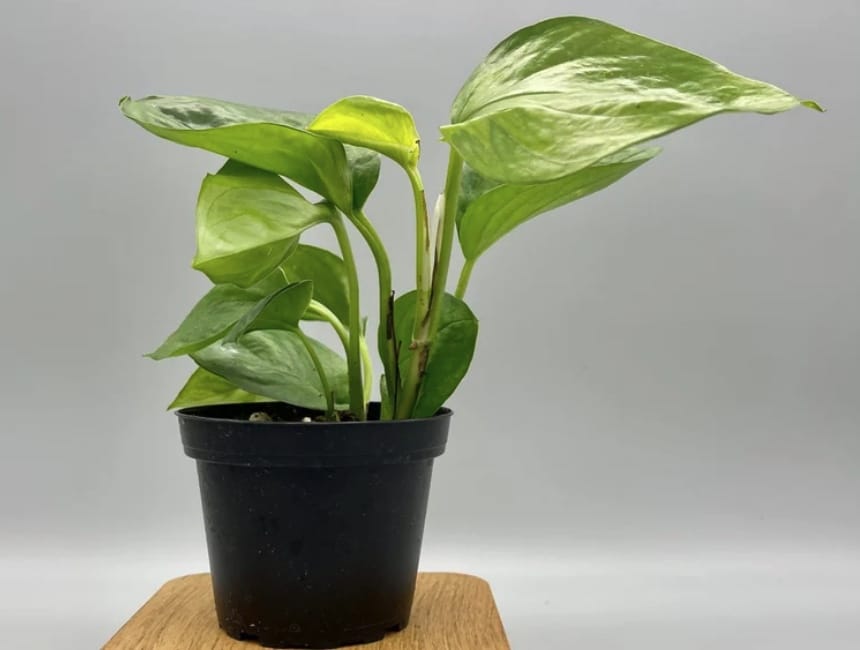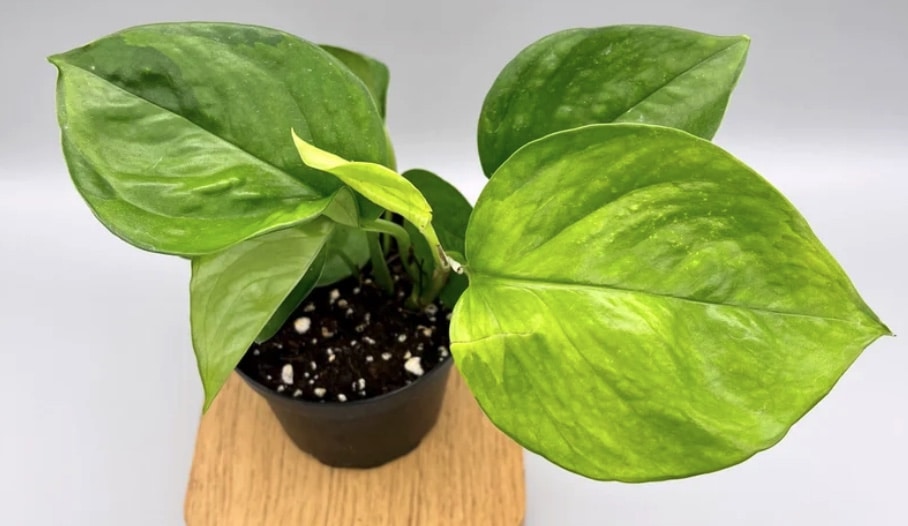Jessenia Pothos (Epipremnum Jessenia) is a beautiful tropical plant that can provide color and comfort to any space. It has beautiful variegated foliage with various green and yellow hues. The plant’s leaves have a smooth texture and a width of about 7 inches. These plants have a bush-like growing habit and produce vines.
They can grow up to 12 feet tall with proper care but are usually between 4 and 6 feet indoors.
This blog post will cover the basics of Jessenia Pothos care. If you’re looking for a lovely plant to bring life into your home or office, this article is for you!
What is a Jessenia Pothos plant?
Jessenia pothos is a species of flowering plant in the family Araceae. With the botanical name Epipremnum aureum Jessenia, these plants are characterized by heart-shaped foliage. The leaves are dark green with yellow and lighter green variegation.
The Jessenia pothos plant originates from tropical rain forests in Central America and Southeast Asia. They are found growing in countries such as China, India, and New Guinea. These plants are commonly kept as houseplants worldwide and can also be grown outside year-round in USDA zones 10 or 11. These plants are slightly slower growing than other species of pothos. They are generally long-living and, in time, can get quite large.
The jessenia Pothos contains calcium oxalate crystals that can irritate skin and mouth tissues – an uncommon occurrence but one that occasionally happens with this species. Keeping pets and young children away from this plant is always a good idea, especially if they chew or eat things around the house.
How to Care for a Jessenia Pothos plant
When provided with the correct conditions, jessenia pothos plants can grow rapidly and produce flowers. The vines of the plant typically reach a length of up to 16ft or more. It is a climbing vine, so it will need something to grow on, such as a moss pole. Here are some tips to help you grow a thriving Jessenia Pothos.
Watering Requirements
Jessenia Pothos likes moist but not soggy soil and will do best when the potting mix can dry slightly between waterings. This plant can absorb too much water, which will result in root rot. Be careful not to overwater your plant by feeling the first 2 inches of soil to see if your plant requires water.
Sunlight Needs
This plant does best when there is medium to high indirect light but can adapt well in low-light as well as fluorescent light conditions. Ensure your plant gets between 6 and 8 hours of sunlight a day. Be careful not to leave your plant in the full sun, or its foliage will get sunburnt. It’s also worth noting that indoor plants can get burnt through the window.
Humidity
Mist the leaves regularly to provide moisture and increase the humidity surrounding your plant to between 50 and 70%. Another great way to increase the humidity surrounding your plant is to group it with other tropical plants. You can also keep your plant in the bathroom or kitchen as these are the most humid rooms in the home. Alternatively, you may like to place a water and pebble tray underneath your pathos plant.
Temperature
Jessenia pothos are very tolerant to changes in temperature, but they do prefer temperatures between 60 and 78F. Don’t leave your plant outside if frost is expected as cold exposure may kill your plant or cause it to drop its leaves.
Soil
Epipremnum Jessenia plants require loose, well-drained soil. They do best when they are in a pot that has good drainage holes in the bottom to prevent root rot. Arrange for some extra space in your pot as the roots will grow large and fast. You can also add a layer of stones or gravel to the bottom of the pot to help with drainage.
Jessenia pothos can be kept in a variety of different sized pots and hanging baskets. They prefer soil that’s neutral or slightly acidic and has a pH range of between 6.1 and 6.5. That being said, these plants are relatively forgiving and will cope with ranges that are slightly out with the recommended pH.
Fertilization
Jessensia pothos plants will benefit from fertilizing once every 2 to 4 weeks during the warmer months. You can use a general houseplant fertilizer or one specially formulated for flowering or tropical plants.
Pruning
Most pothos plants don’t need to be pruned. You’ll need to deadhead flowers and remove dead or damaged leaves throughout the year. You can also prune your Jessenia pothos to help keep it the desired size and shape.
Pests
There aren’t many pests that attack the Jessenia pothos, but it is occasionally affected by scale insects, mites, aphids, and mealybugs, which can be treated with an insecticidal spray or neem oil.
Propagation
Jessenia pothos can easily be propagated by taking cuttings of the vines. Propagation is best done in the spring or summer months. Only take cuttings from a mature plant and choose healthy stems. It’s a good idea to use sterilized scissors or a knife when taking cuttings to stop bacteria from spreading to the plant.
You can either place your cutting in water or dip it in rooting hormone and plant it in a pot. Cover the pot with a small plastic bag to help increase moisture and humidity. Keep an eye on your cutting, and don’t allow it to dry out. It will take a few months for your plant’s root system to establish itself, and then you’ll see new growth on your plant.
Conclusion
Jessenia pothos is tolerant to most conditions and requires minimal care. It is an excellent choice for indoor houseplants and makes a great hanging plant. Aim to place your plant in bright indirect sunlight, water regularly, but be careful not to overwater and fertilize once a month during the growing season.
An Epipremnum Jessenia plant can make a beautiful addition to any home or office but keep the kids and pets away from this potentially dangerous species.

